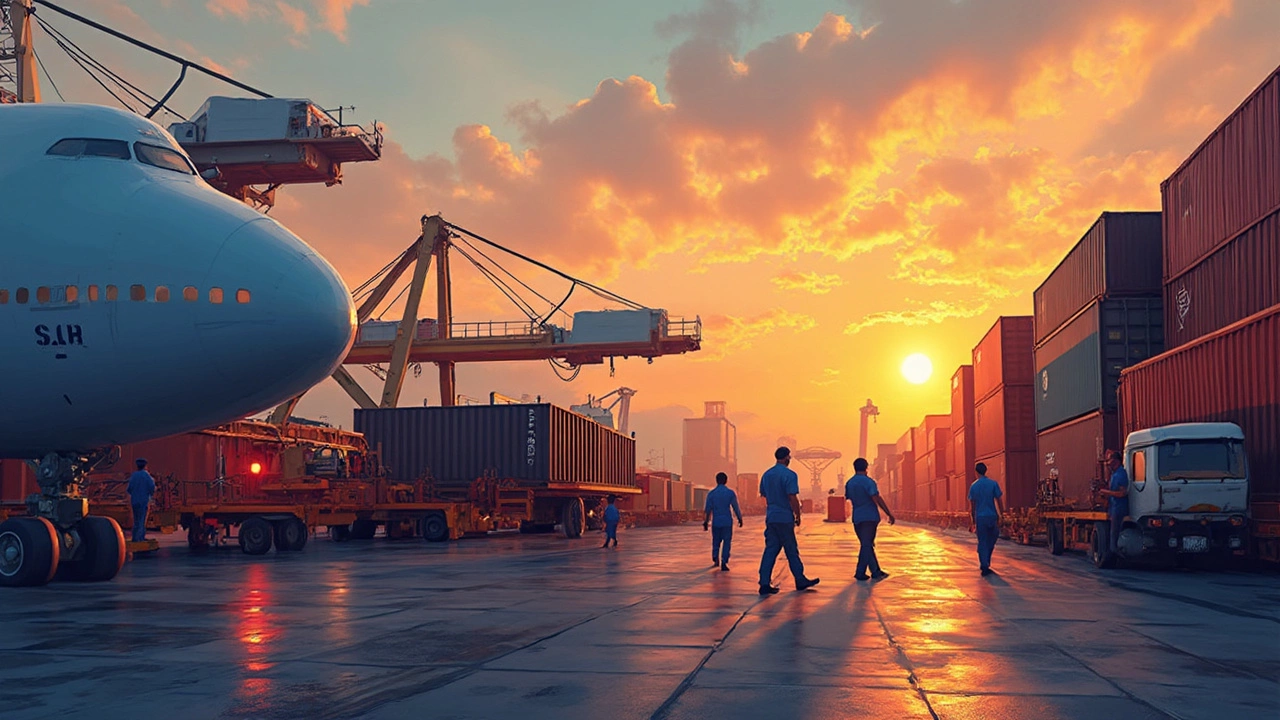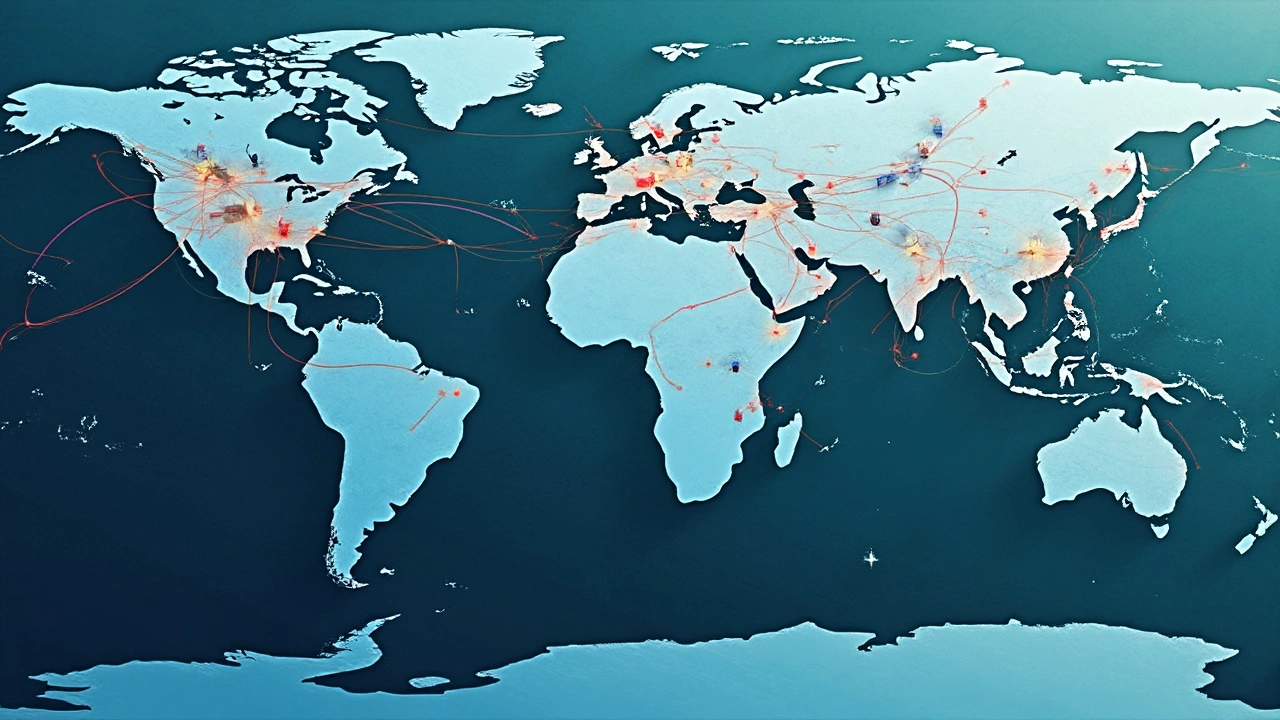Sending a package across the world? It's wild how the cost can surprise you! One of the big reasons is the journey itself. Shipping something from New York to Tokyo isn't just tossing it on a plane—it involves a whole chain of transport steps that get pricier the farther it goes. Plus, the bigger or heavier the package, the more you pay. It's basically getting charged by both the inch and the mile.
But it’s not just the physical trip that racks up the cost. Enter customs duties and fees. Most countries will slap on charges when a package crosses their borders, and guess who ends up footing the bill? Yup, you do. These fees can add up fast and vary depending on what's in the box and where it’s headed.
- The Role of Distance and Size
- Customs Duties and Fees
- Fuel Prices and Their Impact
- Navigating Global Regulations
- Tips for Saving on International Shipping
The Role of Distance and Size
When it comes to international shipping, imagine the cost as a mix of distance and package size. Let's break it down. The farther your package has to travel, the more it's going to cost. Just like when you take a cross-country flight, long hauls get pricey. And it's not just the distance. Bigger or bulkier packages take up more space and are heavier, which also means more money out of your pocket.
Distance isn't just about miles. Think of the logistics involved—getting your package on a plane, then perhaps onto a truck, and maybe even a boat. Every time it changes hands or modes of transport, costs can stack up. A package from Los Angeles to Sydney might stop in multiple places, each adding to the cost.
Size matters, too. Carriers measure packages in what's called dimensional weight. It’s a combination of size and actual weight. Large, lightweight packages can be charged at a rate based on size rather than weight, which might surprise you. You've probably noticed this when packing a suitcase—fill it to the brim, and you're suddenly paying more.
If we look at some data, UPS once reported that smaller packages weighing around 10 lbs sent under 500 miles typically cost about $12. But send that same package abroad, let's say from the US to France, and you're looking at upwards of $70 to $100, even for basic shipping. The size and journey really make the difference.
Want to save some bucks? Keep packages as small and light as possible. Use efficient packing materials, and avoid non-essential items that’ll add weight. Choosing the right box that fits snugly around your items can also reduce those extra charges. Simply put, understanding how package cost dynamics work can help you make smarter, cost-effective shipping decisions.
Customs Duties and Fees
Okay, so let's talk about customs duties and fees because they're like the surprise obstacle course of international shipping. Every country has its own set of rules and costs when it comes to goods entering their borders. These charges can be unavoidable and sometimes unpredictable, depending on what you're shipping and where.
Typically, these fees include duties, taxes, and sometimes handling charges that are applied when your package hits a new country. Duties are primarily taxes imposed on imports to protect local industry, and they vary widely depending on the product category and the destination country. Think electronics, clothes, or beauty items – each category gets treated differently in terms of taxes.
For instance, sending a pair of sneakers might incur a different duty rate than sending a gadget due to their different categories. The European Union, for example, has a set of harmonized rates for different types of goods, while the U.S. calculates duties based on the value and type of goods. These rates can influence whether sending a pricey item is worth the added cost of duties.
Customs fees don't just end with duties—VAT or sales taxes often join the party, especially in countries like the UK, where VAT is tagged onto almost every item that costs over a low value threshold. Sometimes, the courier service may also charge customs brokerage fees for handling the paperwork and payment of these duties for you.
To save a bit of cash, it's smart to be aware of the duty-free thresholds, which are the values of goods you can ship without incurring duties. Study those numbers before you ship because they might save you from unexpected expenses. Also, clearly labeling your items and providing detailed invoices can ensure smoother customs processing, potentially keeping those fees in check.

Fuel Prices and Their Impact
You wouldn't think fuel prices are a big deal when shipping a package, right? But believe me, they are a massive part of why international shipping costs what it does. Airplanes, ships, and trucks guzzle a heck of a lot of fuel, and when global fuel prices go up, guess who gets hit? Yep—those shipping bills climb higher.
Consider this: back in 2022, fuel prices shot up worldwide due to geopolitical tensions. The cost of shipping something as simple as a book from the US to Europe felt like buying two books. Transport companies had to adjust their fees to stay afloat, and we, as customers, bore the brunt of it.
A lot of logistics companies use a thing called a "fuel surcharge," which is basically a percentage they add to your shipping cost to cover high fuel prices. This surcharge shifts according to the fluctuating price of fuel, meaning when oil prices spike, shipping rates generally follow suit.
But here's the hopeful spin: knowing about these surcharges can help plan when to ship your goods. If you can delay sending packages during periods of high fuel costs, you might save a few bucks. Moreover, keeping an eye on the news about oil markets can give you an early warning before those price hikes hit your wallet.
| Year | Average Oil Price (USD per barrel) | Average Shipping Cost Increase (%) |
|---|---|---|
| 2022 | 117 | 8 |
| 2023 | 98 | 5 |
Despite the fuel price rollercoaster, there are opportunities to snag deals. Shipping companies often offer promotions or discounts to lure customers, especially during times when fuel rates drop. So, catching one of these deals alongside lower fuel prices can help keep your shipping fees under control.
Navigating Global Regulations
Alright, so let's talk regulations. If you're scratching your head over international shipping costs, part of the mystery lies in the rules every package must follow. Every country has its own set of regulations and knowing them is like cracking a secret code for avoiding headaches down the line.
First, most nations have a list of prohibited and restricted items. It’s not universal; what’s okay in one place might be a no-go in another. For example, shipping lithium batteries can be tricky because some countries are super strict about it due to safety concerns. It’s smart to check these lists before you even pack.
Then there's the paperwork. Customs requires detailed documentation showing exactly what you're sending and why. Miss a document or fill it out wrong, and your package might hit a major roadblock. The paperwork usually includes a commercial invoice, packing list, and sometimes even certificates of origin.
Oh, and let’s not forget about tariffs and taxes. Depending on where you’re shipping, goods can be hit with import taxes. The rate can change based on the item category and value. A tip? Do your homework on destination-specific tariffs to budget your shipping costs effectively.
Lastly, some countries have entry bans or tighter rules for certain times of the year, like holidays. It’s a good idea to stay updated on these to avoid unexpected delays or extra charges.
Here's a quick look at how different regulations stack up for a few popular shipping destinations:
| Country | Average Tariff Rate | Shipping Restrictions |
|---|---|---|
| USA | 1.6% | Alcohol, certain electronics |
| Australia | 5% | Medicines, books with glue |
| Japan | 2.5% | Plants, animals |
All these factors make understanding and navigating global regulations essential if you want to clear that next package with less stress and cost. So, keep these details in your back pocket and you’ll be a shipping pro in no time.

Tips for Saving on International Shipping
Sending packages internationally doesn’t always have to break the bank. Here are some practical ways you can cut down on those pesky international shipping costs.
First off, consider comparing rates from different carriers. While it might sound like a chore, it can make a huge difference. Websites like Parcel Monkey or Shippo allow you to compare costs across a bunch of services, helping you snag the best deal.
Next, keep an eye on package size and weight. Using the smallest box possible and trimming unnecessary packaging could save you on fees. Some carriers charge by volume, so don't pay for extra air!
If you ship often, consider using a third-party shipping service, which might offer discounts. These services often have deals with major carriers, meaning you can benefit from reduced rates.
- Consolidate Your Shipments: If you’re sending multiple packages to the same destination, see if it’s cheaper to bundle them together. Fewer shipments might mean less money overall.
- Choose Slower Shipping Options: If speed isn’t a factor, opt for slower delivery times. Economy shipping is usually cheaper than express options.
- Be Smart with Customs Forms: Filling out accurate customs forms can prevent extra charges or delays. Declare items truthfully and be clear about their value to avoid issues.
- Look for Promotional Offers: Keep an eye out for promotional deals and coupons from major carriers like FedEx and UPS; these offers can lead to significant savings.
Here's a quick look at how costs can stack up:
| Carrier | Cost for 1kg package (NY to Tokyo) |
|---|---|
| FedEx | $45 |
| UPS | $50 |
| DHL | $43 |
Take these tips to heart and you might just find that shipping fees don’t bite as hard as they used to. Who doesn't love saving some extra cash?


